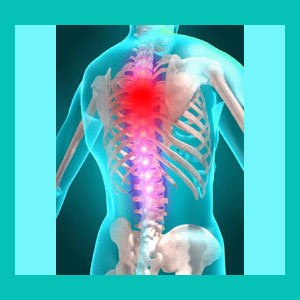
Thoracic herniated disc symptoms are only caused by a small minority of intervertebral protrusions in the upper or middle back regions. Thoracic herniated discs are rare to start with, but the ones which do exist are also statistically cited as the most asymptomatic of all intervertebral bulges. However, for the few patients who do suffer from troublesome thoracic disc issues, the symptoms can present some interesting challenges for treatment.
This dialog details why most thoracic disc irregularities do not generate back pain. We will also examine the minority of thoracic disc pathologies that do produce symptoms.
Absence of Thoracic Herniated Disc Symptoms
As previously mentioned, the thoracic spinal discs are far less likely to suffer a herniation, both from age-related degeneration, as well as from traumatic injury. The thoracic levels of the vertebral column are designed for support and protection, not flexibility. This makes the region enjoy markedly decreased deterioration from movement, as well as reducing the likelihood of sustaining damaging spinal injury.
For people who do endure significant herniations in the middle and upper back regions, the cause is almost always due to focused traumatic injury or an abnormal degenerative process that is related to spinal curvature or a previous spondylodesis surgery.
Most herniations which exist in the middle and upper back are nonissues, since they do not enact any pain or neurological symptoms at all. Better still, these herniations have the best chance of resolving without any treatment whatsoever. Time reduces many of these bulges, since they do not endure recurrent stresses in the thoracic levels.
In a small sample of patients, a thoracic herniation may be painful, although even in this minuscule demographic, the majority of patients may well be misdiagnosed and actually suffering from some other actual underlying symptomatic process.
In cases of truly pathological thoracic disc protrusions, the symptomatic process is usually either central spinal stenosis for large central herniations, or foraminal stenosis for focal paracentral herniations.
Atypical Thoracic Bulging Disc Symptoms
In symptomatic patients, misdiagnosis is the most common explanation for why the herniation seems to be the source of pain. Many of these patients demonstrate coincidental thoracic disc abnormalities, but the symptoms exist due to some other structural spinal, non-spinal, mindbody or disease process.
This occurrence is identical to the same phenomenon seen far more often in the lumbar and cervical levels, wherein disc bulges are blamed for causing pain, but are not the true source of symptomatic expression. However, some thoracic bulging and ruptured discs can actually enact symptoms through spinal stenosis, foraminal stenosis and even chemical radiculitis.
Sometimes, patients with problematic middle back disc issues demonstrate the existence of scoliosis or Scheuermann’s kyphosis. If not, they may well have received prior surgical spinal fusion treatment, as this is known to have a severe degenerative impact on surrounding vertebral levels, facilitating thoracic disc disease and herniations in most patients.
Depending on the exact nature of the pathological process at work, symptoms should correlate to the clinical expectations and should also resolve with appropriate treatment.
Summary of Thoracic Herniated Disc Symptoms
The thoracic spine is simply not required to bend and flex the way our cervical and lumbar levels must perform. This makes a herniated disc in the middle back or upper back an ideal location and far less likely to create any pain or disability. This fact is a very positive characteristic of thoracic disc abnormalities.
However, if you do happen to be one of the few who do suffer from a problematic thoracic herniated disc symptoms, finding appropriate treatment may be more of a challenge. This is due to so much emphasis being placed on cervical and lumbar herniated discs in the back pain therapy sector. For best results, make sure to consider all your treatment options carefully and look for a specialist who is familiar with treating these less common mid and upper back disc issues.
The best curative options for most thoracic disc problems include noninvasive spinal decompression and minimally invasive surgical interventions. Meanwhile the best symptomatic modalities are those that entail minimal ongoing expense, minimal pharmaceutical risk and maximum collateral health benefits, such as exercise, acupuncture and massage.
Herniated Disc > Herniated Disc in the Upper Back > Thoracic Herniated Disc Symptoms





